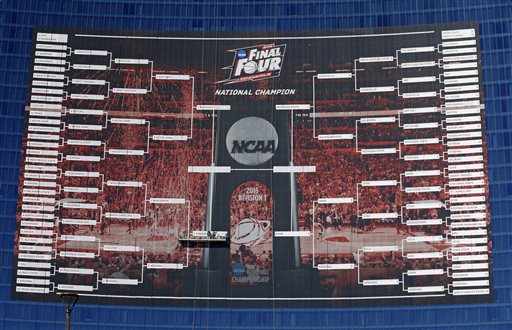
A giant bracket for last year’s March Madness tournament was hung on the side of the JW Marriott building last year in Indianapolis.
The Bracket Battle
Perhaps the most popular part of the madness that is March Madness is the bracket challenge.
The bracket challenge, for those who don’t know, is where people fill in who’s going to win each game of the tournament in hopes of winning a major cash prize. (Of course, you have better odds of winning the Powerball before correctly guessing the outcomes of all 63 games of the NCAA tournament, but that still doesn’t stop millions of people from competing with their friends to see who was more right.)
Anyone can go online to sites like ESPN or CBS to fill in a bracket, no matter what your knowledge of college basketball ranks.
However, with a very unpredictable regular season, it’s safe to say that no one knows what they’re doing, so those with no college basketball knowledge will know just as much as the basketball nerds.
Here are some tips to making your bracket the best it can be:

A giant bracket of last year’s NCAA March Madness Tournament hung from the side of the JW Marriott in Indianapolis last year.
1. Not all the higher seeds will win
Probably one of the biggest pet peeves of many bracketologists is when someone chooses the higher seeds to win the games.
Now, this is fine if it’s all for laughs, but in reality this is not likely to happen, especially this year.
Make sure you have a good number of realistic upsets in the bracket; the Final Four won’t be all #1 seeds!
Also, there’s always a Cinderella team (a lower-seeded team that makes a deep run in the tournament). Always have at least one Cinderella.
2. Look at the BPI for each team
BPI (Basketball Power Index) takes into account multiple factors of a team’s play, including pace of play, speed, strength of opponents, injuries to key players, etc.
If you participate in challenges like ESPN’s Bracket Challenge, the BPI of different teams is available to look at. The BPI is a great indicator of who may win each game, and it can be very helpful when trying to find realistic upsets.
3. Look at team stats
This may not be what everyone likes to do, which is fine, but looking at the stats really helps find the upsets.
How a team ranks nationally in terms of points allowed per game, three-point percentage, field-goal percentage, and rebounds per game are a few key stats that can make a big difference in certain match ups.
It’s also not a bad idea to see who the star or key players of each team have been performing recently. Sometimes a player’s recent play can determine how his team will perform, which can make it easier to find the upsets.
4. Be realistic
Is #16 seed Florida Gulf Coast going to upset a #1 seed? Possibly. Will they win the national title? Probably not.
Be realistic about match ups. If you have a really low seed going against a really high seed, you better be 100% sure that the lower-seeded team has a chance.
5. Watch the games!
Bracket challenges may be one of the most popular parts of March Madness, but the other popular part is the basketball itself!
Watch the games. See how teams do and keep track of your brackets. You can catch the games on TBS, CBS, TNT, and TruTV starting on March 15th with the first four games. The round of 64 starts on March 17th and goes to the 18th.
Best of luck with your brackets, and remember: guess wisely!